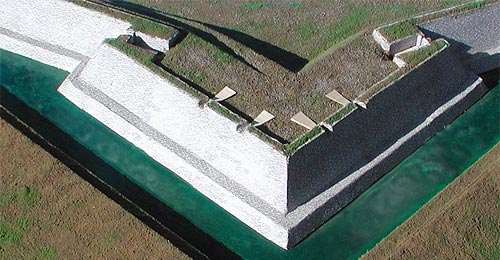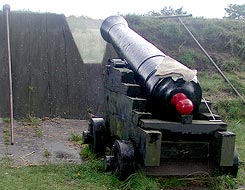Artillery On the Bastion
To say that bastions functioned as flanks into an advancing enemy does not fully describe their utility. Those bastions also elevated and protected the artillery of the besieged, permitting them the advantage of firing down from behind cover.
If a bastion's parapet was low enough, like under a meter, cannon barrels could thrust over the top. But that did not afford much protection for the cannoneers. Better was the parapet that was near two meters high. Unable to fire over their protection, the men had to fire their cannon through slots in the parapet. These slots were termed embrasures, which were wider outside than inside, providing both protection and the ability to aim the cannon within the angle formed.
 |
|
Click here to identify the embrasures
in this masonry bastion Click here to identify the gun platforms And double click either to return to the original image |
Each cannon did not simply rest on the ground. Rather, a
wooden floor was made for each, usually trapezoidal in shape. While keeping
the weapon out of the mud, the platform facilitated lateral
movement of the gun to improve and speed aim. To permit the
barrel to be depressed sufficiently to shoot down on swarming
attackers, the platform was angled slightly to make its rear higher
than the front. This also allowed gravity to help absorb the
cannon's recoil.
 Artillery pieces set on the static bastions were not required to
move but little. Therefore, a big-wheeled carriage with long
trail was not necessary. A more box-like carriage with small
wheels worked as well, and was simpler and easier to construct.
You likely have seen images of this carriage type in movies of
sailing-era adventures, and you could have seen the same deployed in
the defense of some artillery forts.
Artillery pieces set on the static bastions were not required to
move but little. Therefore, a big-wheeled carriage with long
trail was not necessary. A more box-like carriage with small
wheels worked as well, and was simpler and easier to construct.
You likely have seen images of this carriage type in movies of
sailing-era adventures, and you could have seen the same deployed in
the defense of some artillery forts.
